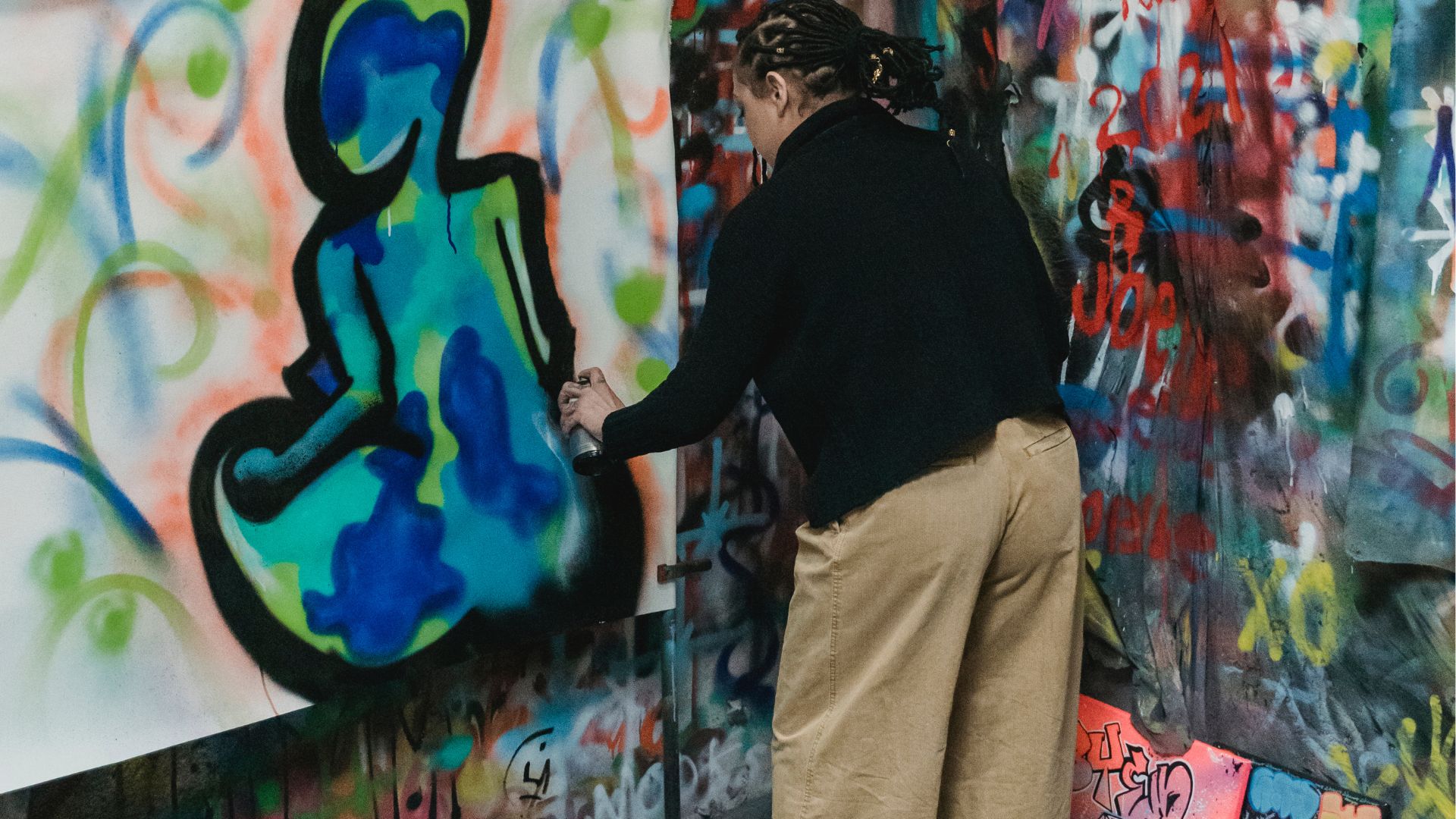Assessing the Existing Mural
Before you start painting over a mural, evaluate its condition. If the mural is in good shape without any peeling or major damage, you can paint over it. However, if there are areas with significant damage or if the mural has a glossy finish, it might require some extra preparation.
Preparation Steps
Clean the Surface
Begin by cleaning the mural surface thoroughly. Use mild soap and water to remove any dirt or dust. Let it dry completely before moving forward.
Sanding and Priming
If the mural has a glossy finish or is particularly smooth, consider sanding it lightly to help the new paint adhere better. Applying a primer specifically designed for the type of surface you’re working on can also enhance paint adhesion and create a smooth base.

Choosing the Right Paint
Select a high-quality paint suitable for the surface and the desired outcome. If the existing mural has vibrant colors or strong patterns, you might need several coats of paint to cover it completely. Using a primer tinted to a similar shade as your new paint can help with coverage.
Painting Techniques
When painting over a mural, apply thin coats of paint evenly. Avoid heavy application, as it may lead to drips or uneven coverage. Let each coat dry completely before applying the next one.
Final Touches
Once you’ve achieved the desired coverage and the wall is dry, step back and admire your work! Consider adding your own creative touch, like a new mural or decorative elements, to personalize the space further.
So,…
Painting over existing murals can be a rewarding project, transforming the look and feel of a room. Remember to assess the mural’s condition, prepare the surface properly, use the right materials, and employ proper painting techniques for a successful outcome.
External Resources for Further Guidance:
Ensuring a Smooth Transition
When painting over existing murals, it’s crucial to ensure a seamless transition between the old and new paint. Here are some additional tips to help you achieve a professional finish:
Patience is Key
Allow each coat of paint to dry completely before applying the next one. Rushing this process may result in an uneven surface or streaky appearance.
Test the Paint
Before diving into painting the entire mural, it’s a good idea to test your chosen paint on a small, inconspicuous area. This allows you to see how well it covers the mural and whether the colors match your expectations.
Blend Colors Appropriately
If the existing mural has bold or vibrant colors, you might need to apply several coats of paint to cover it entirely. Choosing a primer and paint color that closely matches the new shade can facilitate better coverage.
Use Quality Tools
Invest in quality paintbrushes, rollers, and other painting tools. This ensures smoother application and a more professional-looking finish.
Personalize the Space
Consider incorporating your personal style into the new paint job. You can create an accent wall, add decorative patterns, or even commission a new mural to make the space uniquely yours.
External Resources for Further Assistance:
Conclusion
Painting over existing murals can be a rewarding project, transforming the atmosphere of any room. Remember, thorough preparation and patience are essential for achieving a flawless finish. By following these steps and seeking guidance from reputable resources, you’ll be well on your way to creating a refreshed and vibrant space.
Comparison tabular on this
| Consideration | Basic Steps | Additional Tips |
|---|---|---|
| Assessment of Mural | Check for damage and condition | Test paint on a small area before full application |
| Surface Preparation | Clean the surface thoroughly | Use quality tools for better application |
| Sand and prime if necessary | Blend colors to match existing mural | |
| Choosing the Right Paint | Select high-quality paint suitable for the surface | Personalize the space to add your touch |
| Painting Techniques | Apply thin, even coats of paint | Use primer tinted to a similar shade for better coverage |
| Allow each coat to dry completely before the next application |
This table provides a side-by-side comparison of the essential steps involved in painting over existing murals and additional tips to ensure a successful outcome.
Wrapping up
Painting over existing murals is a wonderful way to refresh your space and add your personal touch to a room. Remember, a successful outcome depends on careful assessment, thorough preparation, and patience throughout the process.
By evaluating the mural’s condition, preparing the surface diligently, choosing the right paint, and employing proper painting techniques, you can achieve a seamless transition from the old mural to the new paint. Additionally, don’t hesitate to explore your creativity and personalize the space to make it uniquely yours.
Always refer to reliable resources and seek guidance when needed. With attention to detail and a touch of creativity, you’ll transform your space into something truly special. Happy painting!

For over a decade, I’ve been Mike, an artist, crafter, and designer deeply immersed in the Croc world. I thrive on crafting unique, size-inclusive patterns, fostering creativity, and sharing them on ktforum.com. My designs aim to ignite your creative spark and delight you, ensuring clarity and ease of use through rigorous testing. Join me in expressing your creative flair and showcasing your craft with joy.
Related Posts
- Can You Paint Over Existing Wall Paint on Canvas
If you're an aspiring artist or someone enthusiastic about trying their hand at painting, you…
- Should You Sand a Canvas Before Painting it with Wall Paint
When it comes to using wall paint on canvas, the question of sanding often arises.…
- Testing Wall Paint on Canvas: A Smart Approach to Your Painting Project
When it comes to transforming a canvas into a masterpiece, choosing the right paint is…
- Do you need to use protective gear when painting canvas with wall paint
Absolutely. When embarking on your artistic journey, ensuring your safety is crucial, especially when working…

